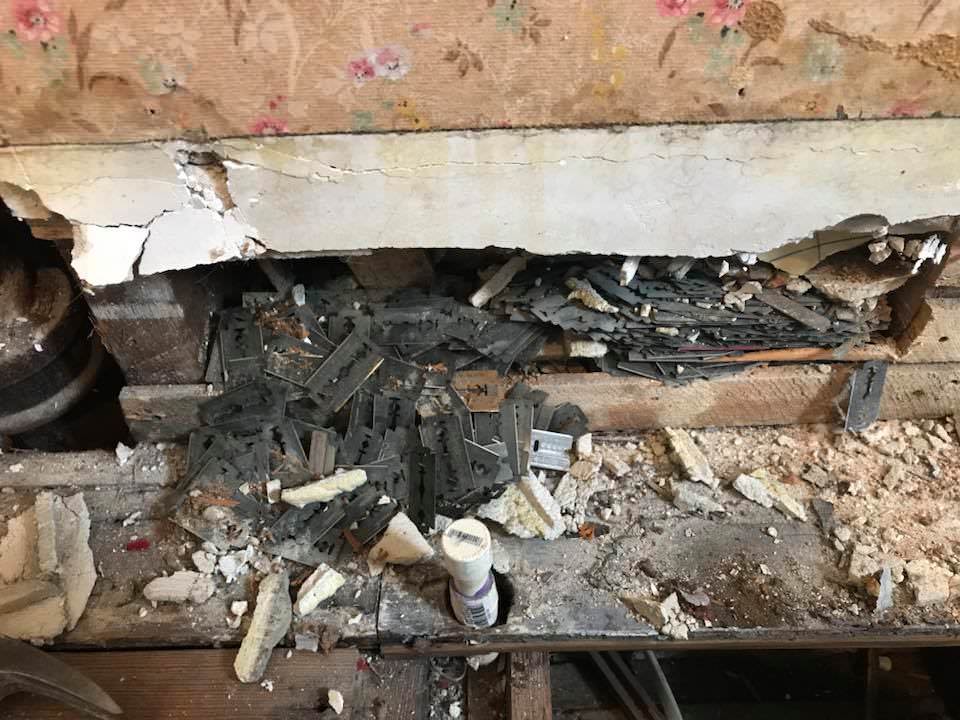The Hidden Danger in the Walls of Your Old House
Let’s say that you live in a house dating back to, oh, the 1940s or so. And let’s also say that you want to remodel one of the bathrooms that are original to the house. When you take down the wall next to your sink, you may want to stand back: the wall may be armed and ready to fight back.
No, the house won’t suddenly become sentient. But there’s a very good chance that dozens if not hundreds of rusty razor blades will suddenly avalanche toward your legs and feet.

The picture above was posted to reddit a few a years ago with the caption “my friend just found a razor blade wall.” And as you can see, the description is spot-on: someone opened up a wall to find what looks like a hundred or so old straight-edge razors. That’s probably not something you’d want to find during some home demo and construction, but it’s also shouldn’t be surprising: walls full of razor blades are a common “feature” (for lack of a better word) of older houses, particularly in their bathrooms. And the reason why is really simple: old home bathroom walls are actually murderous sociopaths only held dormant by our reluctance to invest in expensive renovations.
No, wait, that’s not it. The real reason is that a few generations ago, we didn’t have a great solution for what to do with old shaving razors, and putting them in the empty space in our bathroom walls seemed like a reasonably good solution.
Okay, that also sounds ridiculous. But it’s the truth! Here’s a picture of an old sink (via an architect’s website). Above it, you’ll see a soap dish, a toothbrush holding tray, and in between those two, a slot in a tile that reads “Razor Blades.”

In the early 1900s, it was common for men to get their face shaved at their barber. But that changed pretty quickly. As Reader’s Digest reports, “In 1903 Gillette introduced the first safety razor to give men an at-home option that was safer and easier than using the straight-edge razors used at most barbershops. While these blades take a little more time to master than today’s razors, they were a vast improvement in terms of usability than what was previously available, and soon, nearly everyone was shaving with them.”
But there was a problem — the razor blades weren’t made to be reused too often. You needed to throw them out somehow, and that proved difficult. Reader’s Digest continues:
Because they were sharp (and often contaminated with skin, hair, and occasionally blood) you couldn’t just throw the blades in the trash with the rest of your garbage. People had tried that in the 30s and 40s when trash was regularly burned and the ashes spread in gardens, but razor blades generally survived the low heat of a trash fire and became a huge hazard for gardeners.
The slots above provided a solution, as FamilyHandyMan explains:
“[Starting in the 1950s, o]ld medicine cabinets were installed directly inside the interior walls,” Richard D’Angelo, project manager at JWE Remodeling and Roofing [told FHM]. “These old units had a slot in the back that was used to discard used blades, which would allow them to fall into the wall cavity between framing studs, and collect on top of the bottom-plate stud.”
As there was a lot of empty space in that wall cavity, it could be decades before it filled up. And that was hardly a concern, as it was likely that some sort of innovation would come along to replace this solution. Indeed, that’s exactly what happened: in the years since, we’ve developed better razors and also stopped spreading garbage ash in our gardens. Within twenty or thirty years, the practice of dumping old razor blades into your walls was a thing of the past.
Unfortunately for the unsuspecting home renovator, the already-discarded razors themselves didn’t disappear. So if you’re doing renovations, you may want to keep an eye out for walls brandishing weapons.
Bonus fact: Gillette makes a razor that can also be used for long-distance communication, if you’re in a galaxy far, far away, at least. In the 1999 film “Star Wars I: The Phantom Menace” (which I’m told exists, although I have no memory of it), Jedi Master Qui-Gon Jinn uses a space-age device to talk to people back on a ship. As CBS News points out, the prop is actually a Gillette Ladies Sensor Excel Razor, and Qui-Gon is talking into where the blades go.
From the Archives: There may be razor blades in your walls, but there are almost certainly no razor blades in your kids’ Halloween candy, despite the rumors. Here’s where that myth comes from.
